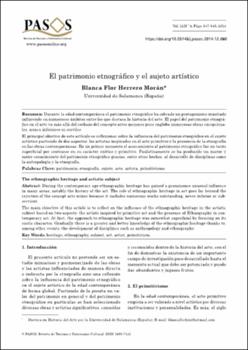El patrimonio etnográfico y el sujeto artístico
Fecha
2014Resumen
Durante la edad contemporánea el patrimonio etnográfico ha cobrado un protagonismo inusitado
influyendo en numerosos ámbitos entre los que destaca la historia del arte. El papel del patrimonio etnográfico en el arte va más allá del rechazo del concepto artes menores pues engloba numerosas obras excepcionales, nunca inferiores ni serviles.
El principal objetivo de este artículo es reflexionar sobre la influencia del patrimonio etnográfico en el sujeto
artístico partiendo de dos aspectos: los artistas inspirados en el arte primitivo y la presencia de la etnografía
en las obras contemporáneas. En un primer momento el acercamiento al patrimonio etnográfico fue un tanto
superficial por centrarse en su carácter exótico y primitivo. Paulatinamente se ha producido un mayor y
mejor conocimiento del patrimonio etnográfico gracias, entre otros hechos, al desarrollo de disciplinas como
la antropología y la etnografía. During the contemporary age ethnographic heritage has gained a prominence unusual influence
in many areas, notably the history of the art. The role of ethnographic heritage in art goes far beyond the
rejection of the concept arts minor because it includes numerous works outstanding, never inferior or subservient.
The main objective of this article is to reflect on the influence of the ethnographic heritage in the artistic
subject based on two aspects: the artists inspired by primitive art and the presence of Ethnography in contemporary art. At first, the approach to ethnographic heritage was somewhat superficial by focusing on its
exotic character. Gradually there is a greater and better knowledge of the ethnographic heritage thanks to,
among other events, the development of disciplines such as anthropology and ethnography.





